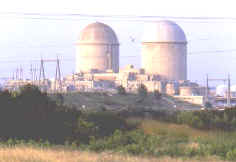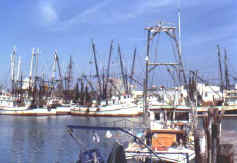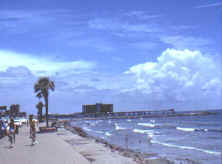Late 20th Century Population and Economic Shifts
The Texas
population
continued its rapid growth throughout the late 1900s. Few inner cities could
adequately accommodate the rapid population growth, and suburbs began to spread
in metropolitan areas. By 1990, Texas ranked second in population in the United States behind California.
The Hispanic population was the fastest growing ethnic group in Texas. Most immigrants moved to fast-growing urban
areas. In 1999, almost 85 percent of Texas' population was
living in metropolitan areas.
| Oil continued to drive the Texas economy in the 1960s and 1970s. The oil
industry and the rising population influenced economic expansion in
real estate, banking, manufacturing and other industries. The high price of oil,
caused by the Organization of Petroleum Exporting Countries (OPEC)
embargo in 1973,
stimulated the state�s
economy. Despite such growth, leaders tried to reduce the state�s dependence
on oil by turning more toward nuclear power as an energy source. The oil boom of the 1970s came to a halt in the
1980s. Early in the decade, oil prices dropped and the state�s economy
suffered. Almost all industries and companies felt the oil crises of the 1980s.
Drilling, refining and other oil related industries cut many of their workers,
and unemployment grew. Banks lost almost $2 billion in just the year 1987. The
real estate business and the railroad industry also suffered marked declines. Texas� ability to rely solely on oil for
growth and prosperity ended.
|

Comanche Park Nuclear Power Plant, Glen Rose
(Photo by J. Griffis
Smith/TxDot) |
In the 1990s, the economy recovered as new
industries such as finance, trade and high-tech companies brought more people
and more wealth to the Lone Star State. The fishing
industry off the Gulf Coast also grew. The
North American Free Trade Agreement
(NAFTA) was negotiated and increased international
trade with Canada and Mexico.
Agriculture continued to remain an important sector of the state�s economy. In
1987, for example, farmers contributed $33 billion to the state economy. Yet,
like the oil business, farmers experienced losses in the 1980s. A drought in
1988 hurt farmers and ranchers. Farms continued to decline in
number, while large land owners and corporations turned to high-production
"agribusiness", based on greater diversification and mechanization.
Tourism started to become an important industry in the state in the 1960s. Since then, tourism has
become more and more important to the Texas economy. National Parks, such as Big
Bend Ranch and Padre Island National
Seashore, bring in
tourists and revenue each year.
Galveston
continues to be a prime
vacation spot with its miles of fantastic beaches.
|

Shrimp boats at Port Isabel
(Photo by Jack Lewis/TxDot)

Galveston Beach
(Photo by Jack Lewis/TxDot) |
In the 1990s, cities like Dallas,
Fort Worth and
San Antonio worked to
clean-up and renovate their downtown areas, making them more attractive and
safer for tourists and locals. San Antonio, for example, developed the famous
"river walk" in the downtown area. That city�s Alamo and Spanish
missions continued to draw thousands of tourists every year, as did
Houston with its
San Jacinto monument and the headquarters for the
space program.
Concerns about the
environment and pollution increased as well during the latter part of
the 1900s. Texas has the largest number of oil refineries and chemical plants in
the nation. Unfortunately, these industries, as well as others, can have a
negative environmental impact. Texas ranks first in the United States in the
amount of known or suspected carcinogens released into the environment.
Texas also leads the nation in the number of hazardous waste disposal sites,
seventy percent of which leak and threaten groundwater. In addition, Texas
industry discharges the highest level of toxic air emissions in the country.
Despite the relative prosperity of Texas, poverty continued to be a problem
for the state. In 1988, 3.1 million Texans lived below the poverty line, with
African Americans, Mexican Americans and the elderly comprising the majority.

Additional Resources
Study Guide Questions:
- What has happened to the population in Texas during
the 1990s?(7.11:C,D)
- What is expected to happen to the population in
Texas by 2030?(7.11:C,D)
- What is "OPEC"? What impact did OPEC have
on the Texas economy in the mid 1970s?(7.7:A)
- What happened to the Texas economy in the 1980s?(7.7:A)
- What industries helped
drive the recovery of the Texas economy in the 1990s?(7.7:A)
- How has the agriculture industry changed in the last
half of the 1900s?(7.12:C)
- What environmental concerns are there in Texas
today?(7.10:A)
Vocabulary
ardently
assassinated
carcinogens
demise
diversification |
embargo
factions
feminist
implemented |
integration
mechanization
reign
stimulated |
Back to Top |